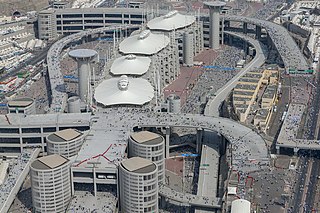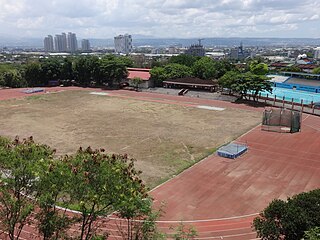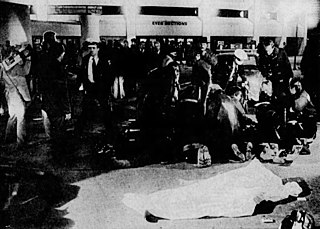
Asphyxia or asphyxiation is a condition of deficient supply of oxygen to the body which arises from abnormal breathing. Asphyxia causes generalized hypoxia, which affects all the tissues and organs, some more rapidly than others. There are many circumstances that can induce asphyxia, all of which are characterized by the inability of a person to acquire sufficient oxygen through breathing for an extended period of time. Asphyxia can cause coma or death.

Crowd psychology is a branch of social psychology that deals with the ways in which the psychology of a crowd is different from the psychology of the individual persons who are in the crowd. The field of crowd psychology enquires into the behaviors and thought processes of both the individual members of the crowd and the crowd as a collective social entity. The behavior of a crowd is much influenced by deindividuation, a person's loss of responsibility, and the person's impression of the universality of behavior, both of which conditions increase in magnitude with size of the crowd. Notable theorists in crowd psychology include Gustave Le Bon, Gabriel Tarde, and Sigmund Freud. Many of these theories are today tested or used to simulate crowd behaviors in normal or emergency situations. One of the main focuses in these simulation works is to prevent crowd crushes and stampares.

Panic is a sudden sensation of fear, which is so strong as to dominate or prevent reason and logical thinking, replacing it with overwhelming feelings of anxiety, uncertainty and frantic agitation consistent with a fight-or-flight reaction. Panic may occur singularly in individuals or manifest suddenly in large groups as mass panic.

The Stoning of the Devil is part of the annual Islamic Hajj pilgrimage to the holy city of Mecca in Saudi Arabia. During the ritual, Muslim pilgrims throw pebbles at three walls, called jamarāt, in the city of Mina just east of Mecca. It is a symbolic reenactment of Ibrahim's hajj, where he stoned three pillars representing the Shaitan, and Muslims' temptation to disobey the will of Allah.

A crowd is as a group of people that have gathered for a common purpose or intent. Examples are a demonstration, a sports event, or a looting. A crowd may also simply be made up of many people going about their business in a busy area.

The Al-Aimmah Bridge disaster occurred on August 31, 2005 when 953 people died following a panic, and subsequent crowd crush, on the Al-Aimmah Bridge, which crosses the Tigris river in the Iraqi capital of Baghdad.

The Jamaraat Bridge is a pedestrian bridge in Mina, Saudi Arabia, near Makkah used by Muslims during the Hajj ritual Stoning of the Devil. The purpose of the bridge is to enable pilgrims to throw stones at the three jamrah pillars either from the ground level or from the bridge. Jamaraat is the plural of jamraah, the Arabic term for each of the pillars involved in the stoning ritual. It literally means a small piece of stone or a pebble.

The PhilSports Stadium Stampede was a crowd crush that occurred at the PhilSports Stadium in Pasig, Metro Manila in the Philippines on February 4, 2006. It killed 73 people and injured about 400. About 30,000 people had gathered outside the stadium waiting to participate in the first anniversary episode of the former television variety show Wowowee.

The 1994 Gowari stampede occurred at Nagpur, India on 23 November 1994 in which 114 people from the Gowari community were killed and 500 more injured. Nagpur Police were trying to disperse almost 50,000 Gowari protesters using a baton charge but it created panic and triggered a stampede amongst the protesters. Gowaris are an ethnic group of central India and are predominantly present in Nagpur. The majority of casualties were women and children who were crushed to death under the crowd's feet as they scrambled to escape the police line. Some were victims of barbed wire piercing as they were climbing over high fences to escape. The Maharashtra state government appointed the one-man Justice S S Dani Commission to investigate the event, but it held nobody responsible and referred to the tragedy as an "unfortunate" one. The Commission justified the police action of baton-charge to control such a huge crowd. The commission also cleared state Chief Minister Sharad Pawar and the rest of the government for any responsibility in the incident. Maharashtra's Tribal Development Minister Madhukar Pichad later resigned, accepting moral responsibility for the tragedy.
The 2008 Naina Devi temple stampede occurred on 3 August 2008 in the Indian state of Himachal Pradesh. 146 people died and 150 were injured when they were crushed, trampled, or forced over the side of a ravine by the movement of a large panicking crowd. Witness accounts suggest that events were initiated after a rain shelter collapsed, which worshipers mistakenly took to be a landslide. There were as many as 3000 devotees at the temple because it was a sacred place in the holy month of Shraavana of the Hindu Calendar. According to Daljit Singh Manhas, a senior police officer from the area, at least 40 of the victims were children.

A stampede is a situation in which a group of large animals suddenly start running in the same direction, especially because they are excited or frightened. Although the term is most often applied to animals, there are cases of humans stampeding from danger too.

The Who concert disaster was a crowd disaster that occurred on December 3, 1979, when English rock band the Who performed at Riverfront Coliseum in Cincinnati, Ohio, United States, and a rush of concert-goers outside the Coliseum's entry doors resulted in the deaths of 11 people.

The Pratapgarh stampede was a crowd crush incident that occurred on 4 March 2010, at Ram Janki temple of the Kripalu Maharaj ashram in Kunda, Uttar Pradesh, India, that killed 63 people and seriously injured 74 more. The incident occurred as 10,000 people attended the temple to receive free items, such as clothes and food, on the first anniversary of the death of the wife of Kripalu Maharaj.

The Estadio Nacional disaster took place on 24 May 1964 at the Estadio Nacional in Lima, Peru, during a match between Peru and Argentina. An unpopular decision by the referee outraged the Peruvian fans, who invaded the pitch. Police retaliated by firing tear gas into the crowd, causing a mass exodus. The deaths mainly occurred from people suffering from internal hemorrhaging or asphyxiation from the crushing against the steel shutters that led down to the street. The incident is considered the worst disaster in the history of association football.

The 2013 Houphouët-Boigny stampede was a crowd crush that occurred as crowds departed a New Year's Eve fireworks display in the early hours of 1 January 2013 near the Félix Houphouët-Boigny Stadium in Abidjan, Ivory Coast. It resulted in 61 deaths and over 200 injuries, mostly women and children. This was the second time in four years that a fatal crush incident occurred at the stadium.

On 24 September 2015, a fatal crowd crush resulted in the death of more than 2,000 individuals, many of whom were suffocated or crushed, during the annual Hajj pilgrimage in Mina, Mecca, Saudi Arabia, making it the deadliest Hajj disaster in history. Estimates of the number of dead vary: the Associated Press reported 2,411 dead, while Agence France-Presse reported 2,236 killed. Based on the total of the individual national reports cited in the table below, at least 2,431 people died. The government of Saudi Arabia officially reported two days after the event that there had been 769 deaths and 934 injured. These figures remained official at the time of the next year's Hajj and were never updated. The largest number of victims were from Iran, followed by Mali and Nigeria.

The 2017 Turin stampede occurred on 3 June 2017 when panic emerged in the Piazza San Carlo after a robbery attempt during a screening of the UEFA Champions League Final in Turin, Italy between local team Juventus and Real Madrid. Three people died as a result of the incident, and at least 1,672 people were injured.
John J. Fruin is an engineer, urban planner, and author known for his work in the field of crowd science. In 1983, he received the American Society of Civil Engineers Transportation Engineering Award.

On 30 April 2021, at about 00:45 IDT (UTC+3), a deadly crowd crush occurred on Mount Meron, Israel, during the annual pilgrimage to the tomb of Rabbi Shimon bar Yochai on the Jewish holiday of Lag BaOmer, at which it was estimated that 100,000 people were in attendance. Forty-five men and boys at the event were killed, and about 150 were injured, dozens of them critically, making it the deadliest civil disaster in the history of the State of Israel. The crush occurred after celebrants poured out of one section of the mountainside compound, down a passageway with a sloping metal floor wet with spilled drinks, leading to a staircase continuing down. Witnesses say that people tripped and slipped near the top of the stairs. Those behind, unaware of the blockage ahead, continued. The people further down were trampled over, crushed, and asphyxiated by compression, calling out that they could not breathe.

Ruggiero Lovreglio is an Italian academic based in Auckland, New Zealand. He is an associate professor at Massey University and a Rutherford Discovery Fellow for Royal Society Te Apārangi. His research is focused on large-scale and small-scale evacuation dynamics and safety training using emerging technologies, such as virtual reality and augmented reality.


















